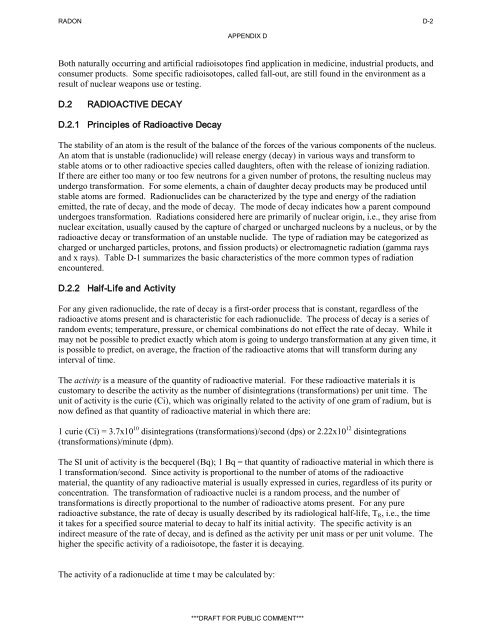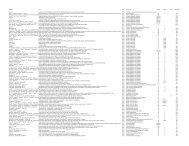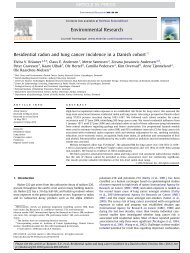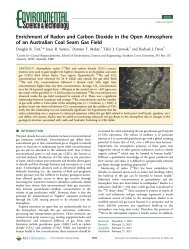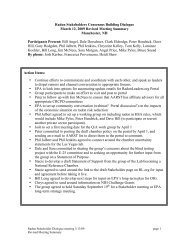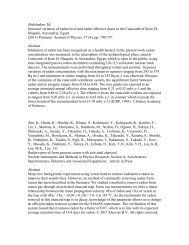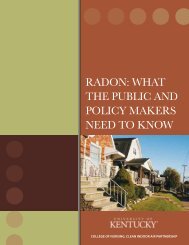ATSDR Draft Toxicological Profile for Radon_September 2008.pdf
ATSDR Draft Toxicological Profile for Radon_September 2008.pdf
ATSDR Draft Toxicological Profile for Radon_September 2008.pdf
You also want an ePaper? Increase the reach of your titles
YUMPU automatically turns print PDFs into web optimized ePapers that Google loves.
RADON D-2APPENDIX DBoth naturally occurring and artificial radioisotopes find application in medicine, industrial products, andconsumer products. Some specific radioisotopes, called fall-out, are still found in the environment as aresult of nuclear weapons use or testing.D.2 RADIOACTIVE DECAYD.2.1 Principles of Radioactive DecayThe stability of an atom is the result of the balance of the <strong>for</strong>ces of the various components of the nucleus.An atom that is unstable (radionuclide) will release energy (decay) in various ways and trans<strong>for</strong>m tostable atoms or to other radioactive species called daughters, often with the release of ionizing radiation.If there are either too many or too few neutrons <strong>for</strong> a given number of protons, the resulting nucleus mayundergo trans<strong>for</strong>mation. For some elements, a chain of daughter decay products may be produced untilstable atoms are <strong>for</strong>med. Radionuclides can be characterized by the type and energy of the radiationemitted, the rate of decay, and the mode of decay. The mode of decay indicates how a parent compoundundergoes trans<strong>for</strong>mation. Radiations considered here are primarily of nuclear origin, i.e., they arise fromnuclear excitation, usually caused by the capture of charged or uncharged nucleons by a nucleus, or by theradioactive decay or trans<strong>for</strong>mation of an unstable nuclide. The type of radiation may be categorized ascharged or uncharged particles, protons, and fission products) or electromagnetic radiation (gamma raysand x rays). Table D-1 summarizes the basic characteristics of the more common types of radiationencountered.D.2.2 Half-Life and ActivityFor any given radionuclide, the rate of decay is a first-order process that is constant, regardless of theradioactive atoms present and is characteristic <strong>for</strong> each radionuclide. The process of decay is a series ofrandom events; temperature, pressure, or chemical combinations do not effect the rate of decay. While itmay not be possible to predict exactly which atom is going to undergo trans<strong>for</strong>mation at any given time, itis possible to predict, on average, the fraction of the radioactive atoms that will trans<strong>for</strong>m during anyinterval of time.The activity is a measure of the quantity of radioactive material. For these radioactive materials it iscustomary to describe the activity as the number of disintegrations (trans<strong>for</strong>mations) per unit time. Theunit of activity is the curie (Ci), which was originally related to the activity of one gram of radium, but isnow defined as that quantity of radioactive material in which there are:1 curie (Ci) = 3.7x10 10 disintegrations (trans<strong>for</strong>mations)/second (dps) or 2.22x10 12 disintegrations(trans<strong>for</strong>mations)/minute (dpm).The SI unit of activity is the becquerel (Bq); 1 Bq = that quantity of radioactive material in which there is1 trans<strong>for</strong>mation/second. Since activity is proportional to the number of atoms of the radioactivematerial, the quantity of any radioactive material is usually expressed in curies, regardless of its purity orconcentration. The trans<strong>for</strong>mation of radioactive nuclei is a random process, and the number oftrans<strong>for</strong>mations is directly proportional to the number of radioactive atoms present. For any pureradioactive substance, the rate of decay is usually described by its radiological half-life, T R , i.e., the timeit takes <strong>for</strong> a specified source material to decay to half its initial activity. The specific activity is anindirect measure of the rate of decay, and is defined as the activity per unit mass or per unit volume. Thehigher the specific activity of a radioisotope, the faster it is decaying.The activity of a radionuclide at time t may be calculated by:***DRAFT FOR PUBLIC COMMENT***


